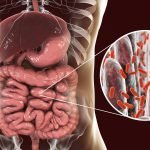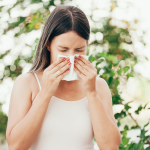Dicentra spp: Remembering a Forgotten Medicine
Eric Yarnell, ND, and Lauren Russel, ND
Dicentra formosa (western or Pacific bleeding heart) and Dicentra canadensis (turkey corn) were once well-known herbal remedies, but have fallen into obscurity. Their potential as anticancer remedies, as well as topical and internal analgesics and sedatives, suggest that they are worth reviewing. Dicentra belongs to the Fumariaceae family and is closely related to the Papaveraceae family, making it a cousin to such notables as the opium poppy and the amphoteric gallbladder remedy Fumaria officinalis (fumitory).
- formosa is a perennial flowering plant most commonly found in the western U.S. from California to British Columbia. It stands 8 to 12 inches high; has deeply lobed, finely divided leaves characteristic of the Ranunculaceae family; and has slightly fragrant, purple, drooping flowers. D. canadensis is very similar but has white flowers and grows primarily in the eastern portion of North America. The name Dicentra is derived from the Greek dis, meaning twice, and centron, meaning spur or “twice-spurred,” describing the shape of its flowers.
Historical Uses
According to Moerman (1998), Pacific bleeding heart was used as an anthelmintic, topical analgesic (for toothache) and to make hair grow by the Native American Skagit people living in the state of Washington. It also was used by the Thompson River Indians in southern British Columbia, though the exact nature of the use was not recorded.
The Eclectics sometimes referred to D. formosa as Corydalis formosa (Corydalis and Dicentra do have some commonalities, but the two genuses should not be confused or considered interchangeable), and used it primarily as an alterative, diuretic and tonic with properties similar to those of the bitter tonics Gentiana or Berberis. According to Eclectic physician Fred J. Petersen, MD, Dicentra “increases the vitality and influences metabolism” (Petersen, 1905). Its tonic properties were extolled by other Eclectic physicians, including Finley Ellingwood, MD; William Cook, MD; Harvey Wickes Felter, MD; and others who found it beneficial in the treatment of syphilitic conditions, blood dyscrasias and “glandular derangements” of the system. Dicentra was also used effectively for amenorrhea, dysmenorrhea and chronic skin disorders. Fluid extracts, compound syrups and tinctures were made from the deep yellow, pea-like tubers of the plant (Felter, 1898), described as “stimulating and moderately relaxing, acting slowly but persistently, and influencing the secretory organs, especially the kidneys and skin” (Cook, 1869). The above-ground parts can also be used.
In traditional Asian herbal medicine, Dicentra spectabilis (bleeding heart) is apparently used for removing blood stasis, expelling pathogenic wind and subduing carbuncles.
Cancer
One of the major areas of application of Dicentra in days past was cancer. Eli Jones, MD, an Eclectic doctor with a large cancer practice, considered Dicentra particularly indicated when the patient had cachexia (Jones, 1911). He recommended a dose of 10 drops of tincture three times per day. Petersen (1905) wrote of it being good for “nodular swelling” and “enlarged glands,” both of which could include at least some cancer patients.
Dicentra contains several isoquinoline alkaloids of interest, including protopine, corydine, isocorydine, bulbocapnine and dicentrine. Several of these have shown cytotoxic and chemoprotective abilities (Choi et al., 2007; Cui et al., 2006). Other compounds from Dicentra related to cardiac glycosides induced apoptosis in human tumor cell lines (McNulty et al., 2007). Clearly, more research is warranted on Dicentra as a treatment for cancer.
Interesting Aporphine Alkaloids
- canadensis has been reported to contain the aporphine alkaloids bulbocapnine and dicentrine (Stern, 2008). Both of these compounds inhibit topoisomerase II in vitro, an action associated with inhibiting cancer cells (Woo et al., 1999). Stevigny and colleagues (2005) reviewed the cytotoxic properties of the aporphinoids and their potential contribution to the development of anticancer agents.
Bulbocapnine is a fairly active tyrosine hydroxylase inhibitor that blocks formation of dopamine, at least in vitro (Shin et al., 1998; Zhang et al., 1997). It also inhibits dopamine-1 receptors in vitro (Schaus et al., 1990). Apparently bulbocapnine has been used “in the treatment of Ménière’s disease, for muscular tremors and as a pre-anaesthetic” (Stern, 2008). Dicentrine also may confer a vasorelaxant and prostate/bladder spasmolytic effect on Dicentra (Yu et al., 1994).
Dose
According to the Eclectics, the tubers of Dicentra should only be collected in the spring when the plant is in flower (Felter and Lloyd, 1898). Flowering tops can also be used when gathered in the summer. A fresh plant tincture is preferred. A typical dose of Dicentra tincture is 1-2ml three times per day. If cut and sifted or powdered herb is used, then the dose is 2-3g three times per day.
Adverse Effects
Some adverse effects have been reported with the administration of Dicentra, though most often these are attributed to overdose. Based on the discussion by Eclectic physician Ellingwood (1919), most problems tend to be gastrointestinal irritation and upset. Dicentra should be considered a moderately potent herb and should be used with caution in frail people or those with serious liver disease.
Among the Eclectics, Dicentra was a leading alterative and tonic for many health conditions, although it has, unfortunately, fallen out of favor among many contemporary practitioners. Further study is needed to identify the chemoprotective and cytotoxic effects of its constituents so that they may be better understood and applied in the prevention and treatment of cancer, for which it holds great promise.
Scudder’s Alterative
An Eclectic medical formula still in use today is Scudder’s Alterative Compound, an herbal tincture formula long used in the treatment of patients with lymphatic and other cancers.
It contains equal parts of:
- Dicentra canadensis (turkey corn) tuber
- Alnus serrulata (black tag alder) bark
- Podophyllum peltatum (mayapple) root (low-alcohol tincture)
- Scrophularia nodosa (figwort) root
- Rumex crispus (yellowdock) root
Dose: 30-40 drops (1-2ml) three to four times a day for up to six months.
 Eric Yarnell, ND is a graduate of Bastyr University. He completed a two-year residency with Silena Heron, ND, and served as chair of botanical medicine at SCNM. He is past senior editor of the Journal of Naturopathic Medicine. Dr. Yarnell is a founding member and current president of the Botanical Medicine Academy and author of numerous textbooks and articles, including Naturopathic Urology and Men’s Health, Naturopathic Gastroenterology and Clinical Botanical Medicine. His area of clinical focus is urology and men’s health. He is assistant professor in botanical medicine at Bastyr University.
Eric Yarnell, ND is a graduate of Bastyr University. He completed a two-year residency with Silena Heron, ND, and served as chair of botanical medicine at SCNM. He is past senior editor of the Journal of Naturopathic Medicine. Dr. Yarnell is a founding member and current president of the Botanical Medicine Academy and author of numerous textbooks and articles, including Naturopathic Urology and Men’s Health, Naturopathic Gastroenterology and Clinical Botanical Medicine. His area of clinical focus is urology and men’s health. He is assistant professor in botanical medicine at Bastyr University.
Lauren Russel, ND is a graduate of Bastyr University, currently focusing on therapies for cancer and endocrine disorders. She has been a medical writer and editor for many years, with numerous publications to her name.
References
Choi SU et al: Cytotoxic isoquinoline alkaloids from the aerial parts of Corydalis incisa, Arch Pharm Res 30(2):151-4, 2007.
Cook W: The Physiomedical Dispensatory, Cincinnati, 1869, self published.
Cui W et al: Potential cancer chemopreventive activity of simple isoquinolines, 1-benzylisoquinolines and protoberberines, Phytochemistry 67(1):70-9, 2006.
Ellingwood F: The American Materia Medica, Therapeutics and Pharmacognosy, Evanston, 1919, Eclectic Medical Publications.
Felter HW, Lloyd JU: King’s American Dispensatory, Sandy, 1898 (reprinted 1983), Eclectic Medical Publications.
Ito C et al: Alkaloids from corydalis, Phytochemistry 29:2044-5, 1990.
Jones E: Cancer: Its Causes, Symptoms and Treatment, Wenatche, 1911 (annotated and reprinted 2003), Healing Mountain Publishing.
McNulty J et al: Discovery of the apoptosis-inducing activity and high accumulation of the butenolides, menisdaurilide and aquilegiolide, in Dicentra spectabilis, Planta Med 73(15):1543-7, 2007.
Moerman DE: Native American Ethnobotany, Portland, 1998, Timber Press.
Petersen FJ: The Materia Medica and Clinical Therapeutics, Los Olivos, 1905, self-published.
Schaus JM et al: Aporphines as antagonists of dopamine D-1 receptors, J Med Chem 33(2):600-7, 1990.
Shin JS et al: Inhibitory effects of bulbocapnine on dopamine biosynthesis in PC12 cells, Neurosci Lett 244(3):161-4, 1998.
Stern KR: Dicentra. Bernhardi, L, Flora of North America (vol 3): www.efloras.org/florataxon.aspx?flora_id=1&taxon_id=109863, 2008.
Stévigny C et al: Cytotoxic and antitumor potentialities of aporphinoid alkaloids, Curr Med Chem Anticancer Agents 5(2):173-82, 2005.
Woo SH et al: Topoisomerase II inhibition by aporphine alkaloids, Biochem Pharmacol 57(10):1141-5, 1999.
Yu SM et al: Effects of dicentrine, a novel alpha 1-adrenoceptor antagonist, on human hyperplastic prostates, Eur J Pharmacol 252(1):29-34, 1994.
Zhang YH et al: Inhibition of tyrosine hydroxylase by bulbocapnine, Planta Med 63(4):362-3, 1997.









